Themed collection #RSCPoster Conference

Density functional theory predictions of the mechanical properties of crystalline materials
The DFT-predicted mechanical properties of crystalline materials are crucial knowledge for their screening, design, and exploitation.
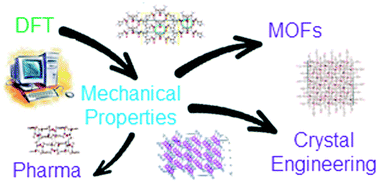
CrystEngComm, 2021,23, 5697-5710
https://doi.org/10.1039/D1CE00453K
A promise to a sustainable future: 10 years of the Green Chemistry Commitment at Beyond Benign
The Green Chemistry Commitment (GCC) was founded in 2013 to host a community of practice around green chemistry in higher education. 10 years later, the GCC empowers a worldwide community to use chemistry tools to create a sustainable planet.

Green Chem., 2024,26, 6983-6993
https://doi.org/10.1039/D4GC00575A
Reconsidering terms for mechanisms of polymer growth: the “step-growth” and “chain-growth” dilemma
Terms used for mechanisms of polymer growth are varied and problematic; we detail here our concerns with the terms “step-growth” and “chain-growth.” Ultimately, we seek terms that are simple, accurate, and attractive to the polymer community.
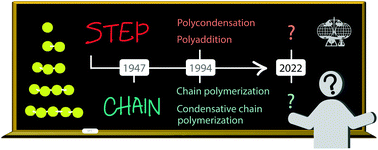
Polym. Chem., 2022,13, 2262-2270
https://doi.org/10.1039/D2PY00086E
Use of some cost-effective technologies for a routine clinical pathology laboratory
Cost-effective technologies allow >85% economical savings, making clinical pathology more accessible worldwide.
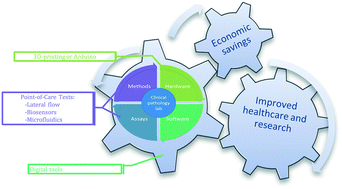
Lab Chip, 2021,21, 4330-4351
https://doi.org/10.1039/D1LC00658D
Targeted modifications in ionic liquids – from understanding to design
The large number of possible ionic liquids makes fully empirical design virtually impossible. In this work, we show how targeted modifications can be and have been used to find the relevant structural features that define the properties of ionic liquids.
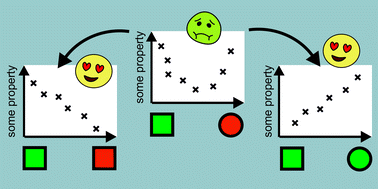
Phys. Chem. Chem. Phys., 2021,23, 6993-7021
https://doi.org/10.1039/D1CP00216C
The Sea's best kept secret: the use of seaweed as a source of biohydrogen for clean and renewable energy
Seaweeds, or macroalgae, have been used for centuries as food additives, fertilizers, and in traditional medicines. Recent uses include energy (fuels) and as a source of bioactive compounds (vitamins and fucoidan).

RSC Sustainability, 2024,2, 1289-1299
https://doi.org/10.1039/D3SU00381G
Harnessing molecular rotations in plastic crystals: a holistic view for crystal engineering of adaptive soft materials
This review highlights the exceptional properties of plastic crystals, their expanding scope in materials sciences and plenty of opportunities for designing new mechanically soft functional crystals.
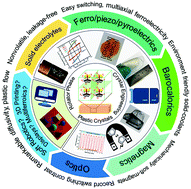
Chem. Soc. Rev., 2020,49, 8878-8896
https://doi.org/10.1039/D0CS00475H
Application of a differential technique in laser-induced fluorimetry/pulsed LED-fluorimetry: simple and reliable analysis of uranium raw materials in the nuclear fuel cycle – a mini-review
Application of differential technique is based on the comparison of the fluorescence of the standard with a sample of similar but unknown concentration on the same sample weight basis, by the use of H3PO4–NH4H2PO4 as a fluorescence-enhancing reagent.

Environ. Sci.: Adv., 2023,2, 1340-1350
https://doi.org/10.1039/D3VA00134B
Crystalline/amorphous nickel sulfide interface for high current density in alkaline HER: surface and volume confinement matters!
In this report, we have developed a novel CA interface between crystalline and amorphous nickel sulfide which required a low overpotential of 15 mV for 10 mA cm−2 with the intrinsic activation for alkaline hydrogen evolution reaction.

Chem. Commun., 2024,60, 6817-6820
https://doi.org/10.1039/D4CC01782J
Unveiling the bifunctional role of morphological differences of self-supported Cu(OH)2 in electrocatalysis
Structure engineering of copper foil by an anodization strategy for developing an electrocatalyst with nanoneedles showed exceptional MOR and OER activity.

J. Mater. Chem. A, 2023,11, 25854-25858
https://doi.org/10.1039/D3TA05471C
Probing the magnetic and magneto-optical properties of a radical-bridged Tb4 single-molecule magnet
The presence of the 1,2,4,5-tetrazinyl radical (tz˙−) in a tetranuclear TbIII metallocence leads to strong magnetic coupling and slow magnetic relaxation. Magneto-optical studies complete the spectroscopical profile of this magnetic unity.
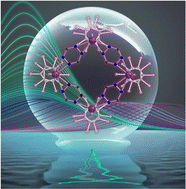
Chem. Commun., 2023,59, 13970-13973
https://doi.org/10.1039/D3CC03034B
An electrochemical cascade process: synthesis of 3-selenylindoles from 2-alkynylanilines with diselenides
Herein, we present an efficient method for synthesizing 3-selenylindoles through an electrochemically driven oxidative cyclization of 2-alkynylanilines with diselenides under mild reaction conditions in an electrochemical undivided cell setup.

Chem. Commun., 2023,59, 8719-8722
https://doi.org/10.1039/D3CC02294C
Optochemical control of Cu(I) homeostasis in mammalian cells
A simple and efficient system for maintaining Cu(I) concentration spatiotemporally.

Chem. Commun., 2023,59, 2315-2318
https://doi.org/10.1039/D2CC05830H
Synthesis of fluorescent carbon nanoparticles by dispersion polymerization of acetylene
Polymerization of acetylene using a Glaser-Hay dispersion polymerization was achieved, yielding spherical CNPs. UV irradiation of these CNPs makes them fluorescent in the blue region.

Nanoscale Adv., 2023,5, 337-343
https://doi.org/10.1039/D2NA00619G
Bio-inspired Cu(II) amido-quinoline complexes as catalysts for aromatic C–H bond hydroxylation
Cu(II)-tetradentate amido-quinoline complexes effectively catalysed aromatic C–H hydroxylation using H2O2 as an oxidant in the absence of an external base with a high selectivity of around 90% for phenols via the non-radical pathway (TON ≥720).

Dalton Trans., 2023,52, 540-545
https://doi.org/10.1039/D2DT03242B
Perovskite chemical gardens: highly fluorescent microtubes from self-assembly and ion exchange
We report the shape-preserving conversion of self-assembled CaCO3 microtubes to PbCO3 and MAPbBr3 perovskite.
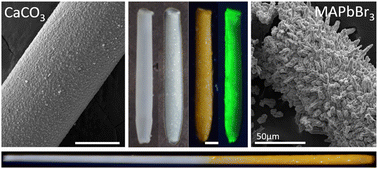
Chem. Commun., 2022,58, 12736-12739
https://doi.org/10.1039/D2CC05611A
Crystalline phosphino(silyl)carbenes that readily form transition metal complexes
We describe the synthesis of phosphino(silyl)carbenes bearing N-heterocyclic imine groups and show that these isolable, crystalline carbenes readily form stable copper(I) and gold(I) complexes.

Chem. Commun., 2022,58, 11831-11834
https://doi.org/10.1039/D2CC04321A
Regioselective access to di- and trisubstituted pyridines via a metal-oxidant-solvent-free domino reaction involving 3-chloropropiophenones
A metal-oxidant-solvent-free domino reaction of 3-chloropropiophenones, enolizable ketones and NH4OAc under an open atmosphere has been developed. This process generates a series of di- and trisubstituted pyridines regioselectively.

Org. Biomol. Chem., 2022,20, 6759-6765
https://doi.org/10.1039/D2OB01193J
A unique water soluble probe for measuring the cardiac marker homocysteine and its clinical validation
In this work, we describe a series of water soluble copper(II) compounds capable of selectively measuring the cardiac marker homocysteine in patients’ blood plasma via fluorescence technique.
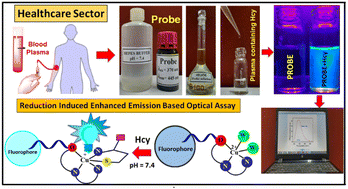
Chem. Commun., 2022,58, 9210-9213
https://doi.org/10.1039/D2CC01515C
Rapid and sensitive naked eye detection of faecal pigments using their enhanced solid-state green fluorescence on a zinc acetate substrate
A cost-effective, nonhazardous, rapid and naked-eye detection approach for sensitive detection of faecal pigments using their enhanced solid-state green fluorescence on a zinc acetate substrate.
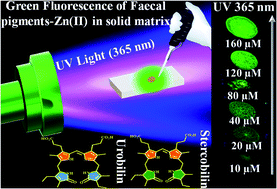
Anal. Methods, 2022,14, 2907-2912
https://doi.org/10.1039/D2AY00878E
Configurational ligand isomerism in conjoined-cages
Isomeric coordination complexes of different configurations (hour-glass and double-decker) but prepared from regioisomeric tridentate ligands are described.
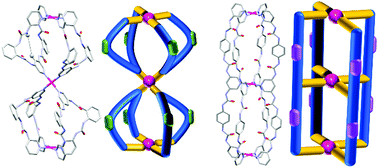
Chem. Commun., 2022,58, 8480-8483
https://doi.org/10.1039/D2CC02837A
Calix[6]arenes with halogen bond donor groups as selective and efficient anion transporters
A calix[6]arene with three preorganised halogen bond donating groups gives >100-fold selectivity for Cl− uniport over HCl symport, in contrast to analogous compounds with strong hydrogen bond donating groups.
![Graphical abstract: Calix[6]arenes with halogen bond donor groups as selective and efficient anion transporters](/en/Image/Get?imageInfo.ImageType=GA&imageInfo.ImageIdentifier.ManuscriptID=D2CC00847E&imageInfo.ImageIdentifier.Year=2022)
Chem. Commun., 2022,58, 6255-6258
https://doi.org/10.1039/D2CC00847E
From PEF to rPEF: disclosing the potential of deep eutectic solvents in continuous de-/re-polymerization recycling of biobased polyesters
For the first time, the design of a urea : zinc acetate DES for a continuous, eco-friendly and closed-loop approach for recycling poly(ethylene 2,5-furandicarboxylate) (PEF) is communicated to avoid its future accumulation in the environment.
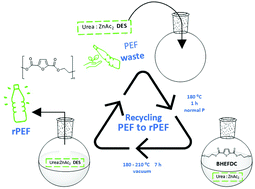
Green Chem., 2022,24, 3115-3119
https://doi.org/10.1039/D2GC00074A
Theoretical framework and experimental methodology to elucidate the supersaturation dynamics of nanocrystal growth
We developed theoretical and experimental methodology to characterize the supersaturation dynamics underlying nanocrystal growth. This can be used to identify supersaturation-associated shape evolutions, and predict growth profiles, of nanocrystals.

Nanoscale Horiz., 2022,7, 376-384
https://doi.org/10.1039/D1NH00572C
Substitution at sp3 boron of a six-membered NHC·BH3: convenient access to a dihydroxyborenium cation
6-SIDipp·BH3 (1) was reacted with I2 to give corresponding iodoboranes (2 & 3), which underwent nucleophilic substitution reactions to furnish OTf and ONO2 substituted boranes (4–7). Treatment of Br2/H2O with 1 led to a dihydroxyborenium cation (8).
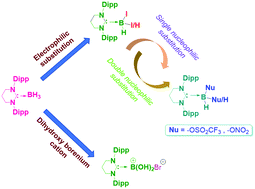
Chem. Commun., 2022,58, 3783-3786
https://doi.org/10.1039/D1CC06816D
An electrochemical study on LiMn2O4 for Al3+ ion storage in aqueous electrolytes
An exclusive study on the Al3+ ion electrochemistry of LiMn2O4 in aqueous electrolytes is illustrated.
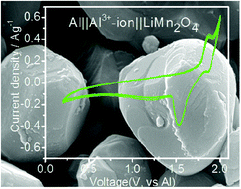
Phys. Chem. Chem. Phys., 2021,23, 19150-19154
https://doi.org/10.1039/D1CP03012D
Annulative Morita–Baylis–Hillman reaction to synthesise chiral dibenzocycloheptanes
The synthesis of racemic and chiral dibenzocycloheptanes has been achieved by employing the intramolecular Morita–Baylis–Hillman reaction as the key step.
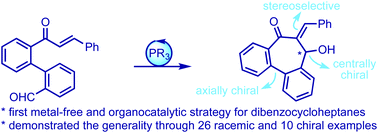
Chem. Commun., 2021,57, 9260-9263
https://doi.org/10.1039/D1CC02765D
Self-assembled nickel cubanes as oxygen evolution catalysts
Ni4O4 cubanes [(μ3-L1O)NiCl(MeOH)]4 (1) and [(μ3-L2O)NiCl(H2O)]4 (2) (L1OH = 1-H-2-benzimidazolylmethanol, L2OH = 1-methyl-2-benzimidazolylmethanol) self-assemble, providing easy access to oxygen evolution electrocatalysts.
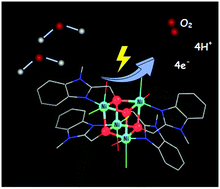
Chem. Commun., 2021,57, 8608-8611
https://doi.org/10.1039/D1CC03227E
Borane catalyzed polymerization and depolymerization reactions controlled by Lewis acidic strength
Triphenylborane catalyzes polyester-block-polycarbonate polymer formation from epoxides, anhydrides and carbon dioxide. Whereas, tris(pentafluorophenyl)borane selectively depolymerizes polycarbonate polymers and blocks.
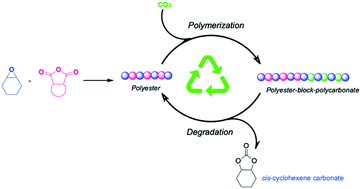
Chem. Commun., 2021,57, 7320-7322
https://doi.org/10.1039/D1CC02218K
Lewis base-free thiophosphonium ion: a cationic sulfur atom transfer reagent
A thiophosphonium ion was isolated in its free, monomeric form for the first time. The highly electrophilic species thionates carbonyl groups already at room temperature and undergoes phosphorus–chalcogen bond metathesis reactions with phosphine oxides, selenides and tellurides.
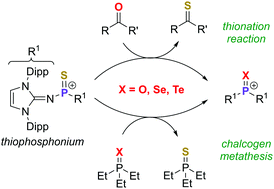
Chem. Commun., 2021,57, 5043-5046
https://doi.org/10.1039/D1CC01273H
Diverse reactivity of carbenes and silylenes towards fluoropyridines
The activation of the para C–F bond of C5F5N by IDipp led to functionalization of all three carbon atoms of the imidazole ring. When the para C–F bond is replaced with a C–H bond, IDipp activates the other C–F bonds leaving the C–H bond intact.
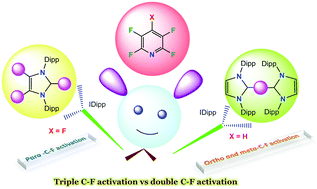
Chem. Commun., 2021,57, 4428-4431
https://doi.org/10.1039/D1CC01401C
Selective DCP detection with xanthene derivatives by carbonyl phosphorylation
Dual mode signalling for DCP detection with rhodamine-6G derivatives through phosphorylation at the spirocyclic carbonyl end.
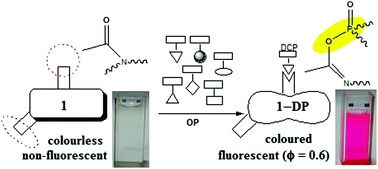
Chem. Commun., 2020,56, 9308-9311
https://doi.org/10.1039/D0CC03985C
Computational discovery of promising new n-type dopable ABX Zintl thermoelectric materials
We develop a chemical replacements in structure prototype (CRISP) approach for novel materials discovery with functional applications.
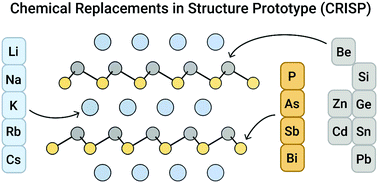
Mater. Horiz., 2020,7, 1809-1818
https://doi.org/10.1039/D0MH00197J
Role of molecular bend angle and biaxiality in the stabilization of the twist-bend nematic phase
Within mean-field theory for V-shaped molecules, we have investigated how the alteration of a molecule's structural features influence the stabilization of modulated and non-modulated nematic phases.
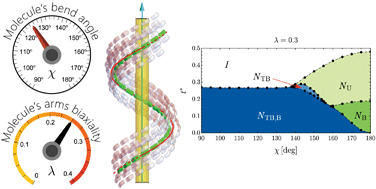
Soft Matter, 2020,16, 4350-4357
https://doi.org/10.1039/D0SM00078G
Oxyanion transport across lipid bilayers: direct measurements in large and giant unilamellar vesicles
A simple, carbazole-based dithioamide receptor transports a variety of biologically relevant anions through lipid bilayers, as shown by direct fluorescent assays in LUVs and GUVs.
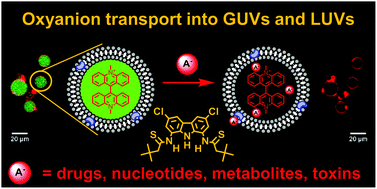
Chem. Commun., 2020,56, 4910-4913
https://doi.org/10.1039/C9CC09888G
Quantification of ion migration in CH3NH3PbI3 perovskite solar cells by transient capacitance measurements
We quantify activation energy, concentration, and diffusion coefficient of mobile ions in MAPbI3 perovskite solar cells using transient ion-drift measurements.
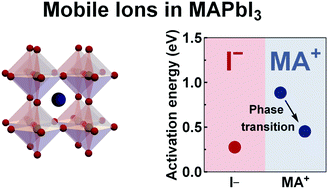
Mater. Horiz., 2019,6, 1497-1503
https://doi.org/10.1039/C9MH00445A
T and V-shaped donor–acceptor–donor molecules involving pyridoquinoxaline: large Stokes shift, environment-sensitive tunable emission and temperature-induced fluorochromism
The critical role of molecular shapes in the environment-sensitive and temperature-induced emission properties of pyridoquinoxaline-based donor–acceptor–donor molecules was demonstrated.

Chem. Commun., 2018,54, 1786-1789
https://doi.org/10.1039/C7CC09261J
Stabilizing an exotic dianionic tetrazine bridge in a Ln2 metallocene
The first structurally and physically characterized complexes bearing the dianion radical of an s-tetrazine are presented and highlight the extraordinary ability of tetrazines to store more than one electron within their six-membered ring.

Chem. Sci., 2024,15, 16234-16242
https://doi.org/10.1039/D4SC03734K
Photochemical halogen-bonding assisted generation of vinyl and sulfur-centered radicals: stereoselective catalyst-free C(sp2)–S bond forming reactions
Constructing alkenyl sulfides has never been so easy! A new halogen-bonding assisted photochemical transformation allows for the catalyst free cross-coupling between vinyl halides and thiols under basic conditions and visible light irradiation.
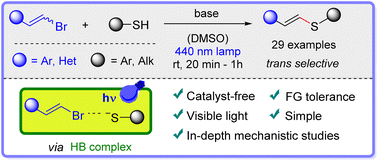
Chem. Sci., 2023,14, 650-657
https://doi.org/10.1039/D2SC05556B
Fluorine extraction from organofluorine molecules to make fluorinated clusters in yttrium MOFs
The reaction of yttrium(III) and linker makes a 2D metal–organic framework. The addition of fluorinated modulators result in fluorine extraction from modulators and makes a 3D-MOF.

Chem. Sci., 2022,13, 14285-14291
https://doi.org/10.1039/D2SC05143E
Room temperature chemoselective hydrogenation of C![[double bond, length as m-dash]](https://www.rsc.org/images/entities/char_e001.gif) C, C
C, C![[double bond, length as m-dash]](https://www.rsc.org/images/entities/char_e001.gif) O and C
O and C![[double bond, length as m-dash]](https://www.rsc.org/images/entities/char_e001.gif) N bonds by using a well-defined mixed donor Mn(I) pincer catalyst
N bonds by using a well-defined mixed donor Mn(I) pincer catalyst
Chemoselective hydrogenation of C![[double bond, length as m-dash]](https://www.rsc.org/images/entities/char_e001.gif) C, C
C, C![[double bond, length as m-dash]](https://www.rsc.org/images/entities/char_e001.gif) O and C
O and C![[double bond, length as m-dash]](https://www.rsc.org/images/entities/char_e001.gif) N bonds in α,β-unsaturated ketones, aldehydes and imines is accomplished at room temperature (27 °C) using a well-defined Mn(I) catalyst and 5.0 bar H2.
N bonds in α,β-unsaturated ketones, aldehydes and imines is accomplished at room temperature (27 °C) using a well-defined Mn(I) catalyst and 5.0 bar H2.
![Graphical abstract: Room temperature chemoselective hydrogenation of C [[double bond, length as m-dash]] C, C [[double bond, length as m-dash]] O and C [[double bond, length as m-dash]] N bonds by using a well-defined mixed donor Mn(i) pincer catalyst](/en/Image/Get?imageInfo.ImageType=GA&imageInfo.ImageIdentifier.ManuscriptID=D2SC05274A&imageInfo.ImageIdentifier.Year=2022)
Chem. Sci., 2022,13, 13764-13773
https://doi.org/10.1039/D2SC05274A
Carrier gas triggered controlled biolistic delivery of DNA and protein therapeutics from metal–organic frameworks
We can alter the release kinetics of highly stabilized biomacromolecules in both skin and plant tissues to allow for either instant release or slow release simply by changing the typeof gas used in a pneumatic delivery jet.
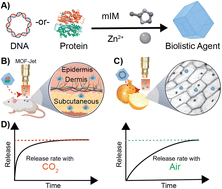
Chem. Sci., 2022,13, 13803-13814
https://doi.org/10.1039/D2SC04982A
Exploring the configurational space of amorphous graphene with machine-learned atomic energies
Machine-learning models for atomic energies can be used to drive Monte-Carlo structural exploration, and also to obtain new insight into disordered structures – as demonstrated here for amorphous graphene.

Chem. Sci., 2022,13, 13720-13731
https://doi.org/10.1039/D2SC04326B
Towards new coordination modes of 1,2,3-triazolylidene: controlled by the nature of the 1st metalation in a heteroditopic bis-NHC ligand
The nature of the first metal coordination electronically influences the 1,2,3-triazolium moiety in [L2-H2]Br2, which leads to the unprecedented selective activation of triazole C4/C5 positions as supported by the isolation of several bimetallic complexes.

Chem. Sci., 2022,13, 13387-13392
https://doi.org/10.1039/D2SC05024B
Total synthesis of the antibacterial polyketide natural product thailandamide lactone
A convergent strategy for the total synthesis of the structurally intriguing polyketide natural product thailandamide lactone has been developed for the first time. The antibacterial activity of the molecule has also been disclosed.

Chem. Sci., 2022,13, 13403-13408
https://doi.org/10.1039/D2SC04727F
Thiazole fused S,N-heteroacene step-ladder polymeric semiconductors for organic transistors
Ladder-type thiazole-fused S,N-heteroacenes with an extended π-conjugation consisting of six (SN6-Tz) and nine (SN9-Tz) fused aromatic rings have been synthesized and fully characterized.
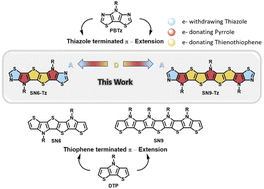
Chem. Sci., 2022,13, 12034-12044
https://doi.org/10.1039/D2SC04661J
Perpetuating enzymatically induced spatiotemporal pH and catalytic heterogeneity of a hydrogel by nanoparticles
This work reports perpetuating effect in enzymatically generated spatiotemporal pH gradient across a hydrogel in presence of cationic gold nanoparticle; showing a new route in spatially resolved chemistry in a membrane-free environment.
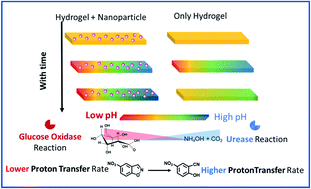
Chem. Sci., 2022,13, 8557-8566
https://doi.org/10.1039/D2SC02317B
Point mutations in SARS-CoV-2 variants induce long-range dynamical perturbations in neutralizing antibodies
Mutations in the new variants of SARS-CoV-2 spike protein modulates the dynamics of the neutralizing antibodies. Capturing such modulations from MD simulations and graph network model identifies the role of mutations in facilitating immune evasion.
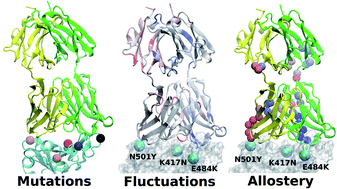
Chem. Sci., 2022,13, 7224-7239
https://doi.org/10.1039/D2SC00534D
Pressing matter: why are ionic liquids so viscous?
We use an experimental approach to compare an ionic liquid with a molecular mimic, focusing on viscosities. Charge network and coulombic compaction contribute significantly to the high viscosity of ionic liquids; we discuss the implications on their design and optimisation.
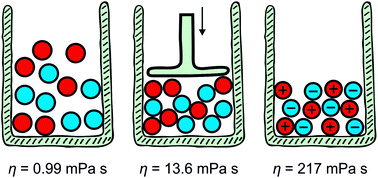
Chem. Sci., 2022,13, 2735-2743
https://doi.org/10.1039/D1SC06857A
Spatiotemporal dynamics of self-assembled structures in enzymatically induced agonistic and antagonistic conditions
We have shown ATP-driven spatiotemporally distinct self-organization pattern of a surfactant in a two-dimensional space using enzymes, demonstrating a new route for obtaining ‘spatial’ organizational adaptability among interacting components.
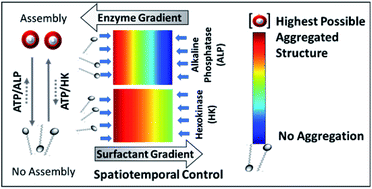
Chem. Sci., 2022,13, 274-282
https://doi.org/10.1039/D1SC05353A
Direct synthesis and applications of solid silylzinc reagents
The first direct synthesis of PhMe2SiZnI and Me3SiZnI reagents from silyl iodides is described. They can be obtained as solids and stored at 4 °C for extended periods. The versatility of solid Me3SiZnI is demonstrated in a variety of reactions.

Chem. Sci., 2021,12, 15719-15726
https://doi.org/10.1039/D1SC06038D
Mg(II) heterodinuclear catalysts delivering carbon dioxide derived multi-block polymers
Carbon dioxide-based multiblock polymers are synthesised, in one-pot, from a mixture of monomers using a highly selective and active heterodinuclear Co(II)Mg(II) catalyst.
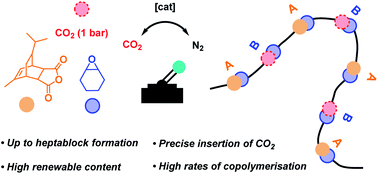
Chem. Sci., 2021,12, 12315-12325
https://doi.org/10.1039/D1SC03856G
Dissipative operation of pH-responsive DNA-based nanodevices
We demonstrate here the use of 2-(4-chlorophenyl)-2-cyanopropanoic acid (CPA) and nitroacetic acid (NAA) as convenient chemical fuels to drive the dissipative operation of DNA-based nanodevices.
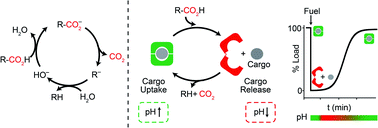
Chem. Sci., 2021,12, 11735-11739
https://doi.org/10.1039/D1SC03435A
Effects of turn-structure on folding and entanglement in artificial molecular overhand knots
Spacers linking 2,6-pyridinedicarboxamide units influence the tightness of the corresponding lanthanide-coordinated overhand knot. β-Hairpin forming motifs generate a metal-coordinated pseudopeptide with a knotted tertiary structure.

Chem. Sci., 2021,12, 1826-1833
https://doi.org/10.1039/D0SC05897A
Stability of radical-functionalized gold surfaces by self-assembly and on-surface chemistry
We have investigated the radical functionalization of gold with a derivative of the perchlorotriphenylmethyl radical using two methods: by chemisorption from the radical solution and by on surface chemical derivation from a precursor.
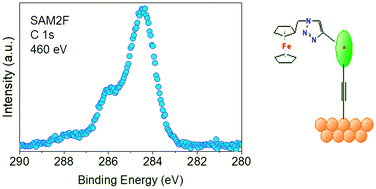
Chem. Sci., 2020,11, 9162-9172
https://doi.org/10.1039/D0SC03399E
Conformational design concepts for anions in ionic liquids
Interchangeable functional groups for imide ions are investigated computationally, new ILs with low/high viscosity are designed a priori and experimentally characterised.

Chem. Sci., 2020,11, 6405-6422
https://doi.org/10.1039/D0SC01379J
Evolutionary chemical space exploration for functional materials: computational organic semiconductor discovery
Evolutionary optimisation and crystal structure prediction are used to explore chemical space for molecular organic semiconductors.
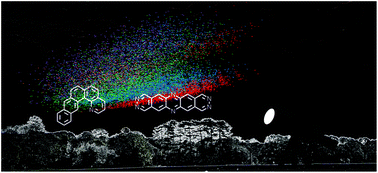
Chem. Sci., 2020,11, 4922-4933
https://doi.org/10.1039/D0SC00554A
Predicting retrosynthetic pathways using transformer-based models and a hyper-graph exploration strategy
We present an extension of our Molecular Transformer model combined with a hyper-graph exploration strategy for automatic retrosynthesis route planning without human intervention.
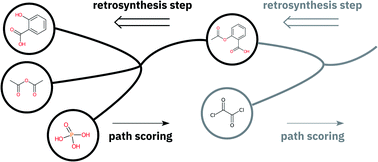
Chem. Sci., 2020,11, 3316-3325
https://doi.org/10.1039/C9SC05704H
Insights into mechanochemical reactions at the molecular level: simulated indentations of aspirin and meloxicam crystals
Working towards a fundamental description of mechanochemical reactions through the use of classical molecular dynamics simulations. Capturing the transfer of molecules between two non-volatile molecular crystals during mechanochemical events.
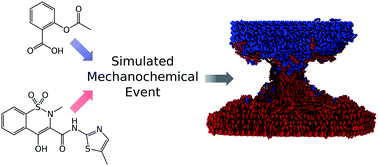
Chem. Sci., 2019,10, 2924-2929
https://doi.org/10.1039/C8SC04971H
Engineering of imidazo[1,2-a]pyridine into multifunctional dual-state emissive (DSE) luminogens for hydrazine sensing and cell-imaging
Balancing the donor–acceptor (D–A) systems and spatial configurations to precisely modulate dual-state emission (DSE) properties in imidazo[1,2-a]pyridine-derived luminogens for applications in cell imaging and hydrazine sensing.
![Graphical abstract: Engineering of imidazo[1,2-a]pyridine into multifunctional dual-state emissive (DSE) luminogens for hydrazine sensing and cell-imaging](/en/Image/Get?imageInfo.ImageType=GA&imageInfo.ImageIdentifier.ManuscriptID=D4TC04343J&imageInfo.ImageIdentifier.Year=2025)
J. Mater. Chem. C, 2025,13, 3955-3968
https://doi.org/10.1039/D4TC04343J
Exploring nickel-catalyzed organochalcogen synthesis via cross-coupling of benzonitrile and alkyl chalcogenols with computational tools
The reaction mechanism of Ni(0)-catalyzed C–S cross-coupling between benzonitrile and propanethiol has been studied with DFT and validated by microkinetic modeling. The protocol is used to assess its potential usage for building C–Se and C–Te bonds.

Org. Biomol. Chem., 2025,23, 1673-1682
https://doi.org/10.1039/D4OB01865F
C–H bond chlorination and bromination using water soluble nickel(II) guanidine complexes
Water-soluble nickel(II)-guanidine-based complexes successfully catalyzed the C–H chlorination of a series of hydrocarbons in the presence of NaOCl and acetic acid in water–chloroform (7 : 3, biphasic condition) at room temperature.

Dalton Trans., 2025,54, 503-510
https://doi.org/10.1039/D4DT02783C
Solvent-free confinement of ordered microparticle monolayers: effect of host substrate and pattern symmetry
We report a solvent-free assembly method where microspheres align on fluorocarbon patterns without rigid boundaries, creating tunable crystal patterns. Our findings highlight the impact of tribocharging and substrate elasticity on particle ordering.

Soft Matter, 2024,20, 9413-9423
https://doi.org/10.1039/D4SM01196A
Unveiling the impact of enhanced hydrophobicity of ZIF-71 on butanol purification: insights from experimental and molecular simulations
The incorporation of bromide atoms into ZIF-71 significantly enhances its hydrophobicity, leading to a preference for acetone adsorption over butanol.

Dalton Trans., 2024,53, 18998-19006
https://doi.org/10.1039/D4DT02485K
Soft micron-sized polypeptide microgels: preparation, crosslink density, topography and nanomechanics in swollen state
We report an innovative preparation of soft micron-sized polypeptide microgels by horseradish peroxidase (HRP)-mediated crosslinking in inverse suspension.

Mater. Adv., 2024,5, 5984-5997
https://doi.org/10.1039/D4MA00356J
Coinage metal-ethylene complexes of sterically demanding 1,10-phenanthroline ligands
Bulky phenanthroline provides ideal support to stabilize ethylene complexes of copper(I), silver(I) and gold(I), permitting their complete characterization. Copper complexes catalyze the carbene insertion to C–H bonds of adamantane.
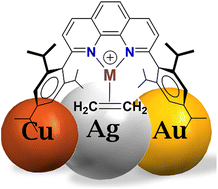
Dalton Trans., 2024,53, 10426-10433
https://doi.org/10.1039/D4DT00822G
Preparation of von Hippel-Lindau (VHL) E3 ubiquitin ligase ligands exploiting constitutive hydroxyproline for benzylic amine protection
Step economical routes for the multigram preparation of popular VHL E3 ligase recruiting ligands.

RSC Adv., 2024,14, 17077-17090
https://doi.org/10.1039/D4RA01974A
Harnessing halogen bond donors for enhanced nitrogen reduction: a case study on metal-free boron nitride single-atom catalysts
Catalyst design for NH3 synthesis is vital yet challenging. This study highlights the role of halogen bond donors as catalytic promoters, aiding activation of N2. This study offers insights for robust metal-free catalysts and promoters in NRR research.

Phys. Chem. Chem. Phys., 2024,26, 12495-12509
https://doi.org/10.1039/D4CP00076E
Augmentation of inductive effects through short range intramolecular hydrogen bonds for the improvement of cooperativity of trimeric rosettes
Three key design elements improve the binding strength of trimeric rosettes: the direction of hydrogen bonds, the addition of groups with inductive effects, and the presence of ambifunctional intramolecular hydrogen bonds between the substituents.

Mol. Syst. Des. Eng., 2024,9, 345-351
https://doi.org/10.1039/D4ME00008K
Validating superior electrochemical properties of Ti3C2 MXene for supercapacitor applications through first-principles calculations
This work investigates the performance of Ti3C2 MXene for supercapacitor applications and validated its efficacy as an electrode material utilizing first-principles calculations.

New J. Chem., 2024,48, 4982-4994
https://doi.org/10.1039/D3NJ05075K
About this collection
The annual #RSCPoster Conference (https://rsc.li/poster) is our flagship celebration of science, drawing together researchers to network with peers, engage in scientific debate and share their research with the global chemistry community. Previously taking place on Twitter, the event now takes place for 24 hours on LinkedIn each year. Following feedback from participants, we are showcasing work from poster presenters in this collection to give a more permanent home to the research presented.
If you have participated in an #RSCPoster and would like to present your work in this collection, please see our survey at https://www.smartsurvey.co.uk/s/RSCPoster/. Please note that to be featured, your work must be published in a Royal Society of Chemistry journal; we cannot display articles at other publishers on this platform. We will be continuously updating the collection and adding articles as requested by presenters, so please return to this page to view the latest works from the #RSCPoster community.